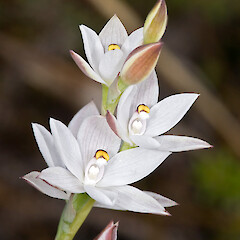Thelymitra longifolia
Common name
white sun orchid, māikuku
Synonyms
Thelymitra alba Colenso, Thelymitra nemoralis Colenso, Thelymitra angustifolia Hook.f., Thelymitra aristata sensu Hatch nom. inv., Thelymitra forsteri Sw., Thelymitra grandis F.Muel. ex Benth., Thelymitra longifolia var. alba (Colenso) Cheeseman, Thelymitra longifolia var. forsteri (Sw.) Hatch, Thelymitra purpureo-fusca Colenso
Family
Orchidaceae
Flora category
Vascular – Native
Endemic taxon
No
Endemic genus
No
Endemic family
No
Structural class
Orchids
NVS code
The National Vegetation Survey (NVS) Databank is a physical archive and electronic databank containing records of over 94,000 vegetation survey plots - including data from over 19,000 permanent plots. NVS maintains a standard set of species code abbreviations that correspond to standard scientific plant names from the Ngä Tipu o Aotearoa - New Zealand Plants database.
THELON
Chromosome number
2n = 26
Current conservation status
The conservation status of all known New Zealand vascular plant taxa at the rank of species and below were reassessed in 2017 using the New Zealand Threat Classification System (NZTCS) – more information about this can be found on the NZTCS website. This report includes a statistical summary and brief notes on changes since 2012 and replaces all previous NZTCS lists for vascular plants.
Please note, threat classifications are often suggested by authors when publications fall between NZTCS assessment periods – an interim threat classification status has not been assessed by the NZTCS panel.
- Conservation status of New Zealand indigenous vascular plants, 2017 . 2018. Peter J. de Lange, Jeremy R. Rolfe, John W. Barkla, Shannel P. Courtney, Paul D. Champion, Leon R. Perrie, Sarah M. Beadel, Kerry A. Ford, Ilse Breitwieser, Ines Schönberger, Rowan Hindmarsh-Walls, Peter B. Heenan and Kate Ladley. Department of Conservation. Source: NZTCS and licensed by DOC for reuse under the Creative Commons Attribution 4.0 International licence.
2017 | Not Threatened
Previous conservation statuses
2012 | Not Threatened
2009 | Not Threatened
2004 | Not Threatened
Distribution
Indigenous. New Zealand: Manawatāwhi / Three Kings Islands, North Island, South Island, Stewart Island/Rakiura, Chatham Islands, Auckland Islands. Also on Norfolk Island.
Habitat
Coastal to subalpine (up to 1200 m a.s.l.). Occupying a wide range of habitats from open ultramafic talus to dense forest. However, it is most common in shrublands. This species is extremely variable and it is likely that following taxonomic revision, a number of forms, some with distinct ecologies, may be formally segregated.
Detailed description
Terrestrial, tuberous, glabrous, spring to summer-green perennial herb, either solitary or in dense colonies of 4–20 plants arising through vegetative extension. Plant at flower up to 1 m tall (usually much less). Leaf solitary, erect, suberect or trailing the ground, very fleshy to subcoriaceous, deeply to weakly channelled and prominently ribbed longitudinally, 50–380 × 10–40 mm, green, dark green, reddish-green, reddish brown or yellow-green, lanceolate to linear-lanceolate, base closely sheathing, margins, surface and apex often disfigured by black spots and sometimes by prominent dark orange-brown rust pustules. Flowering stem stiffly erect, rather wiry, green, reddish green to brownish green. Bracts 1–2–(3), foliaceous, closely-sheathing, fleshy, of similar colour to stem and leaf. Raceme bearing (1)–5–(20) scented or unscented flowers. Flowers 8–18 mm diameter, externally red-green to dark green, internally white or very pale pink, segments spreading, widely spreading or scarcely opening. Dorsal sepal slightly broader than lateral sepals. Petals and labellum alike, narrowly ovate, subacute. Column up to 8 mm long, erect, basally brown or white grading to dark brown to almost black toward apex; column arms terete, mostly bent inwards such that they are lying more or less under post-anther lobe; cilia abundant, floccose (like cotton) or coarsely ciliate, white or cream, short and crowded in globose masses; post anther lobe overtopping anther, dark and smooth above middle, and usually yellowish on the semi-circular cucullate apex.
Manaaki Whenua Online Interactive Key
Similar taxa
Most likely to be confused with Thelymitra colensoi Hook.f. and T. pauciflora R.Br., from both of which it differs by its usually white, sometimes pale pink flowers. From T. pauciflora it is readily separated by the broad, undivided, hooded column which usually completely encloses the cilia of the column arms. Smaller forms are separated from T. colensoi by their white flowers and broader, taller column which completely encloses the cilia of the column arms.
Flowering
September–February
Flower colours
Red/Pink, White
Fruiting
October–April
Propagation technique
Moderately easy to grow. Does well in a pot. Should not be removed from the wild. This species often naturalises into gardens adjoining indigenous vegetation. It is sometimes seen as a pot contaminant of commerical plant lines.
Etymology
thelymitra: Woman’s hat
longifolia: Long leaf
Where To Buy
Not commercially available.
Taxonomic notes
At least three forms of T. longifolia are included here. One is usually associated with montane beech (Nothofagaceae) forests. This is a small slender plant, which has a linear-lanceolate yellow-green leaf and usually a single, scarcely opening, self-pollinating white flower. Another is a widespread variable plant with numerous flowers, which are unscented, and mostly only open on hot, still, sunny days. This form has column arm cilia that are distinctly floccose (like cotton wool). It is self pollinating and matches the type. The last form has numerous scented flowers, which open in sunny or cloudy weather, and coarse column arm cilia. This form is insect pollinated.
Attribution
Fact Sheet prepared for NZPCN by P.J. de Lange 14 April 2007. Description subsequently published in de Lange et al. (2007) and Rolfe & de Lange (2010).
References and further reading
de Lange P, Rolfe J, St George I, Sawyer J. 2007. Wild orchids of the lower North Island. Department of Conservation, Wellington, NZ. 194 p.
Rolfe JR, de Lange PJ. 2010. Illustrated guide to New Zealand sun orchids, Thelymitra (Orchidaceae). Jeremy Rolfe, Wellington, NZ. 57 p.
NZPCN Fact Sheet citation
Please cite as: de Lange, P.J. (Year at time of access): Thelymitra longifolia Fact Sheet (content continuously updated). New Zealand Plant Conservation Network. https://www.nzpcn.org.nz/flora/species/thelymitra-longifolia/ (Date website was queried)

























